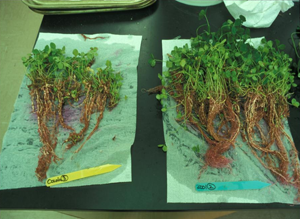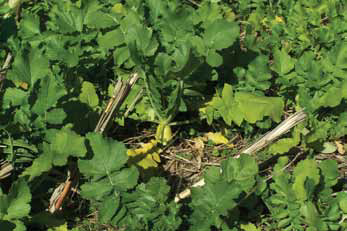 |
|
|
 |
 |
|
|
| |
 |
Will Ladino Clover
- Increased forage quality
- Excellent regrowth following grazing
- Superior winterhardiness
- High yield potential
- Excellent persistence
|
| Management Recommendations |
| Plant Rate |
1.5 - 2#/A |
| Seeding Dates(fall) |
8/15 - 9/ 15 |
| Seeding Dates(spring) |
2/20 - 4/1 |
|
|
|
 |
|
 |
|
|
 |
 |
 |
|
|
| |
OCOEE LADINO CLOVER
- Significant tolerance to southern root-knot nematodes
- High forage yield potential
- Superior persistence
- Released by the University of Florida, selected from Osceola
- Adapted to southeast and transition zones
Ocoee is a new, elite ladino clover with significant tolerance to southern root-knot
nematodes. This tolerance translates into increased stand longevity for farmers in areas where
nematodes cause reductions in yields and contribute to stand decline. Released by the University
of Florida, Ocoee is the result of breeding work to develop a variety combining the positive
attributes of Osceola with improved tolerance to southern root-knot nematodes. Ocoee is widely
adapted and will thrive in the southeast and transition regions of the US. Increased forage
quality, high yield potential and stand longevity are important characteristics of Ocoee and
make it an ideal choice for pasture or hay operations. Ocoee offers many benefits when
overseeded into established grass pastures including improved animal performance, increased
yields and nitrogen supplied to companion grasses via nitrogen fixation.
2nd stage larvae counts 8 weeks
after inoculation with 3 isolates
of southern root-knot nematodes
(Greenhouse Study-UF) |
|
|
2nd stage larvae counts 16 weeks
after inoculation with 3 isolates
of southern root-knot nematodes
(Greenhouse Study-UF) |
| |
|
|
|
|
|
|
|
|
|
| Entry |
|
Mean (1) |
|
|
|
Entry |
|
Mean (1) |
|
| Ocoee |
|
65 |
|
|
|
Ocoee |
|
212 |
|
| Osceola |
|
469 |
|
|
|
Osceola |
|
1482 |
|
| |
|
|
|
|
|
|
|
|
|
(1) Means differ at the 0.05% level of probability according to DNMR test |
|
|
(1) Means differ at the 0.05% level of probability according to DNMR test |
|
|
| Forage Yield Summary
Agronomy Forage Research Unit
Gainesville, FL 2003-2004 |
| |
|
|
| Variety |
|
Yield (lbs/A) |
| Ocoee |
|
2754 |
| Osceola |
|
2268 |
| Regal |
|
2317 |
| Patriot |
|
1527 |
| Durana |
|
1598 |
| LSD (0.05) |
|
260 |
|

A replication of plants for Osceola (left and Ocoee (right) 16 weeks after inoculation in a greenhouse study
|
|
|
|
 |
|
 |
|
|
 |
 |
 |
|
|
| |
ECO-TILL™ SOILBUSTER™ CLOVERS AND RADISHES
- Superior, deep penetrating taproot
- Reduces soil compaction
- Builds organic matter
- Improves nutrient recycling
- Excellent weed suppression
- Enhances soil tilth
|
Eco-Till™ Soilbuster Radish is a new Daikon type forage radish specifically developed for
fall/winter cover crop applications. These radishes offer impressive benefits to the soil and the
environment including the reduction of soil compaction, improved nutrient recycling, increased
organic matter, enhancement of soil tilth and suppression of weeds to name a few.
A superior, deep penetrating taproot is one characteristic that separates Eco-Till™ Soilbuster™
radishes from the competition. The thin, lower portion of the taproot can grow to a depth of six feet or
more while the thick upper portion of the taproot can grow to a length of 24 inches. This taproot
creates vertical holes in the soil profile that breaks up soil compaction and improves soil tilth. This
process, known as "bio-drilling", improves water infiltration, aeration and fertilizer efficiency for
succeeding crops. Equally important is the ability of these radishes to take up nutrients from the soil
profile to be stored in the tissues near the soil surface and make them readily available for use by the
following crop.
Based on the decision of the U.S. Department of Agriculture (USDA) on January 27, 2011, Genuity® Roundup Ready® Alfalfa seed is
available for sale and distribution by authorized Seed Companies or their dealers for use in the United States only. This seed may not be
planted outside of the United States, or for the production of seed, or sprouts.
Monsanto Company is a member of Excellence Through Stewardship® (ETS). Monsanto products are commercialized in accordance
with ETS Product Launch Stewardship Guidance, and in compliance with Monsanto's Policy for Commercialization of
Biotechnology-Derived Plant Products in Commodity Crops. This product has been approved for import into key export markets with
functioning regulatory systems. Any crop or material produced from this product can only be exported to, or used, processed or sold in
countries where all necessary regulatory approvals have been granted. Do not export Genuity® Roundup Ready® alfalfa seed or crop,
including hay or hay products, to China pending import approval. It is a violation of national and international law to move material
containing biotech traits across boundaries into nations where import is not permitted. Growers should talk to their grain handler or product
purchaser to confirm their buying position for this product. Excellence Through Stewardship® is a registered trademark of Biotechnology
Industry Organization.
ALWAYS READ AND FOLLOW PESTICIDE LABEL DIRECTIONS. Roundup Ready® crops contain genes that confer tolerance
to glyphosate, the active ingredient in Roundup® brand agricultural herbicides. Roundup® brand agricultural herbicides will kill crops that
are not tolerant to glyphosate. Roundup Ready® and Roundup® are registered trademarks of Monsanto Technology LLC. ©2011 Monsanto
Company.
Management Recommendations:
- Planting Rate:
- Conventional or No-Till Drill: 8-10 lbs/Acre.
- Broadcast: 12-15 lbs/Acre (broadcast seed needs a light disking or rolling with a corrugated roller to ensure proper seed to soil contact).
- Planting Date:
- North of Interstate 80- Late July to August 15. Between Interstate 40 & Interstate 80- Late July to September 15.
- Seeding Depth:
- 1/4 - 1/2 inch (can be planted up to 1" if soil conditions are dry)
- Germination:
- 3-7 days (with proper soil temperatures and moisture.
- Fertility:
- Apply as directed by soil test. Nitrogen deficiency will limit overall growth, the ability to compete with woods and root penetration through compacted soils.
- Soil pH:
- 6.5 - 7.0 (for optimum performance)
|
 |
|
|
|
 |
|
 |
|
|
 |
|
  |
|